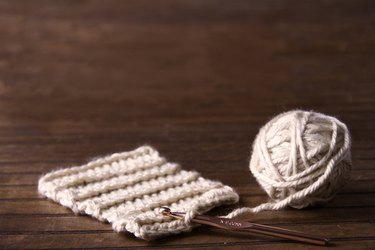
If you've mastered the chain stitch and the single crochet stitch, congratulations -- you've conquered the skills needed to create the so-called foundation row at the start of any crochet project. Once you've completed the foundation row, it's time to move on to the second row that establishes the pattern for the rest of the project.
The Foundation Row
Video of the Day
If you haven't yet worked the foundation row for your project, here's how:
Video of the Day
- Chain the number of stitches you want to work in future rows, plus one.
- Single crochet in the second chain from the hook, and every chain across.
Once you've done that, you're ready to work the turning chain for the next row.
Working the Turning Chain
The turning chain is a short string of chain stitches. Done properly, the turning chain creates just enough slack in the edge of the project for your next row to sit evenly above the first, with no gathers or puckers along the edge, but with not so much slack that it leaves a gap. The length -- also called height -- of the turning chain depends on which stitch you use to begin the next row.
- If the next row starts with a single crochet, chain one stitch.
- If the next row starts with a half double crochet, chain two.
- If the next row starts with a double crochet, chain three.
- If the next row starts with a triple or treble crochet, chain four.
There is some room for variation in turning chains. For example, if you find that a turning chain of three creates an unsightly gap when done before a row that starts with a double crochet, try chaining only two instead.
Turning Your Work
Once you've created the turning chain, flip your work from right to left as if you were turning the page of a book. This is called turning your work, and it positions the crochet work you've already done so that you can work back across the row from right to left. You'll be doing the same two steps -- first making the turning chain, then turning your work -- at the end of every row.
Working the Second Row
Unless the pattern you're working from tells you otherwise, always work the first stitch of your second row into the last stitch of the previous row. Or, to put it another way, you'll work the first stitch of the second row into the gap that's closest to the turning chain, on what's now the right-hand side of the work.
For example, if you were going to work a second row of single crochet, you'd insert your hook into the stitch closest to the turning chain, making sure it goes under both strands of yarn at the top of the stitch. Those strands look somewhat like a "V" when viewed from the top. Yarn over and pull a loop of yarn back through the stitch, leaving you with two loops on the hook. Then yarn over again and draw the yarn back through both loops on the hook, continuing the single crochet stitch.
Continue working in every stitch across the row until you get to the end, and, when you're ready, experiment with working rows of taller stitches like the half double crochet or double crochet. Just make sure you first create a turning chain of appropriate height.